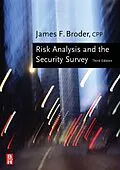Risk Analysis and the Security Survey, Third Edition, provides an understanding of the basic principles of risk analysis. Addressing such topics as cost/benefit analysis, crime prediction, and business continuity planning, the book gives an overview of the security survey, and instructs its readers on ways to effectively produce a survey that will address the needs of any organization. This edition has been thoroughly revised and updated, with an eye toward the growing threat of global terrorism. It includes two new chapters, addressing such topics as disaster recovery planning, mitigation, and the evolving methodologies that are a result of the Homeland Security Act. The book will serve as a core textbook on understanding risk to the growing number of security and Homeland Security programs. It is designed for students in security management courses, security managers, other security professionals as well as business professionals at all levels concerned with security, risk mitigation, and the management aspects of security operations. - Covers Business Impact Analysis (BIA), Project Planning, Data Collection, Data Analysis and Report of Findings, and Prediction of Criminal Behavior- Presents updated statistical information and practical case examples - Helps professionals and students produce more effective results-oriented security surveys
Autorentext
James F. Broder, CFE, CPP, FACFE, has more than 40 years experience in security and law
enforcement. He has worked as a security executive, instructor, and consultant as well as having
served in Vietnam as a Police Advisor in the Counter Insurgency Directorate, Vietnamese
National Police. A former FBI Special Agent and employee for the US State Department, U.S. House of Representatives, Washington D.C. Mr. Broder is considered to be one of the most highly respected security authorities in the United States.
Klappentext
Risk Analysis and the Security Survey, Third Edition, provides an understanding of the basic principles of risk analysis.
Addressing such topics as cost/benefit analysis, crime prediction, and business continuity planning, the book gives an overview of the security survey, and instructs its readers on ways to effectively produce a survey that will address the needs of any organization. This edition has been thoroughly revised and updated, with an eye toward the growing threat of global terrorism. It includes two new chapters, addressing such topics as disaster recovery planning, mitigation, and the evolving methodologies that are a result of the Homeland Security Act. The book will serve as a core textbook on understanding risk to the growing number of security and Homeland Security programs.
It is designed for students in security management courses, security managers, other security professionals as well as business professionals at all levels concerned with security, risk mitigation, and the management aspects of security operations.
- Covers Business Impact Analysis (BIA), Project Planning, Data Collection, Data Analysis and Report of Findings, and Prediction of Criminal Behavior- Presents updated statistical information and practical case examples
- Helps professionals and students produce more effective results-oriented security surveys
Inhalt
TABLE OF CONTENTS
Chapter 1: Risk
Chapter 2: Vulnerability and Threat Identification
Chapter 3: Risk Measurement
Chapter 4: Quantifying and Prioritizing Loss Potential
Chapter 5: Cost/Benefit Analysis
Chapter 6: Other Risk Analysis Methodologies
Chapter 7: The Security Survey: An Overview
Chapter 8: Management Audit Techniques and the Preliminary Survey
Chapter 9: The Survey Report
Chapter 10: Crime Prediction
Chapter 11: Determining Insurance Requirements
Chapter 12: Mitigation and Preparedness
Chapter 13: Response Planning
Chapter 14: Business Continuity Planning
Chapter 15: Business Impact Analysis
Chapter 16: Plan Documentation
Chapter 17: Crisis Management Planning for Kidnap, Ransom and Extortion
Chapter 18: Monitoring Safeguards
Chapter 19: The Security Consultant
APPENDICES
A. Security Survey Work Sheets
B. Danger Signs of Fraud, Embezzlement, and Theft
C. Professional Practices for Business Continuity Planners
D. Sample BIA Introduction Letter
E Sample Kidnap and Ransom Contingency Plan
F. How to Establish Notice
G. Communicating with the Media
H. Security System Specifications
I. Sample Introduction Memorandum: Disaster Recovery Planning
